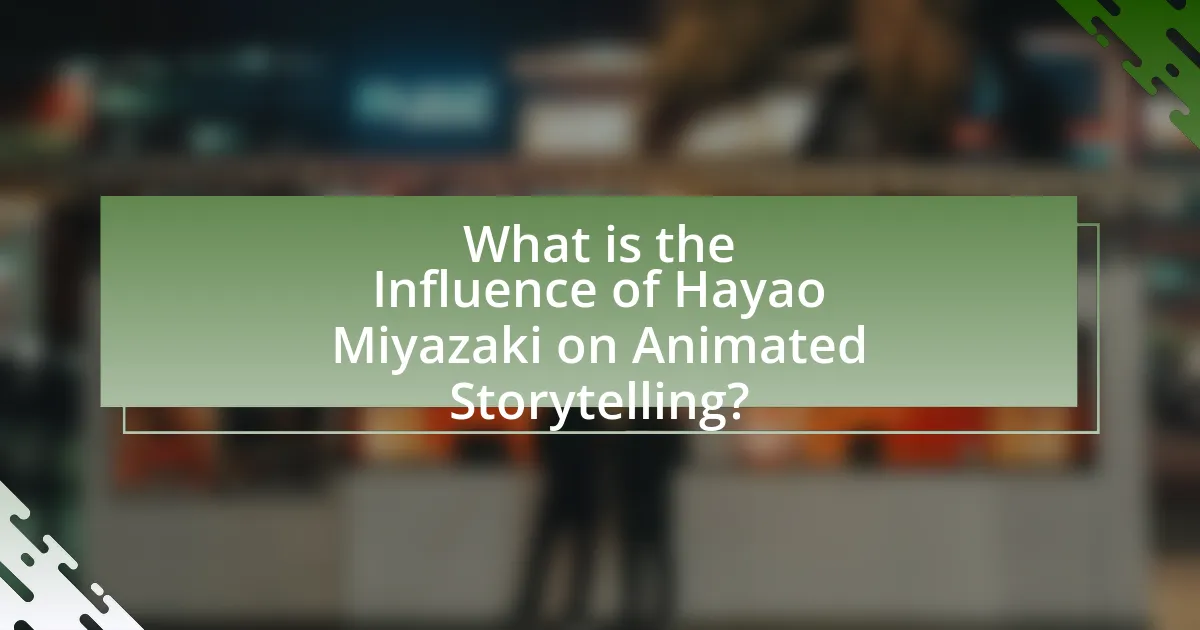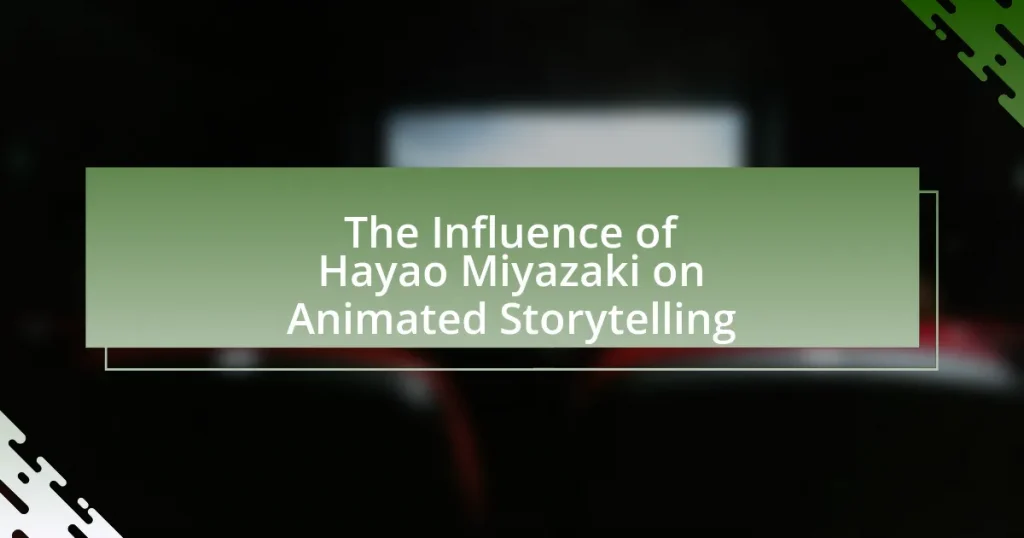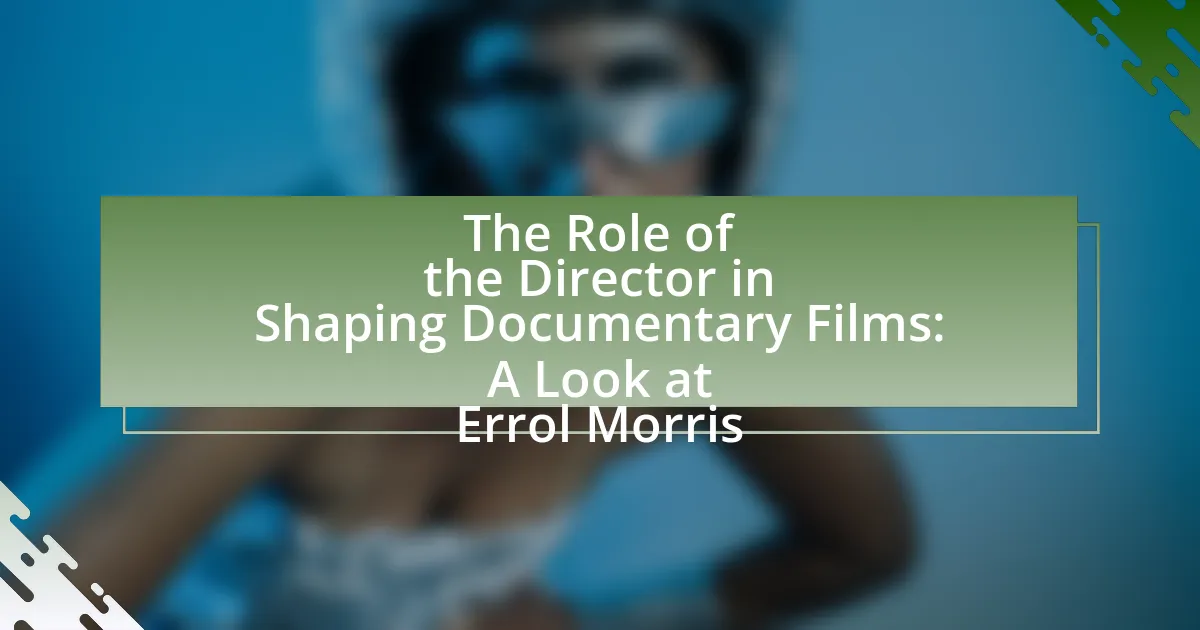Hayao Miyazaki is a pivotal figure in animated storytelling, renowned for his unique narrative style, character development, and thematic depth. His films, including “Spirited Away” and “My Neighbor Totoro,” explore complex themes such as environmentalism, identity, and the innocence of childhood, while featuring strong, multifaceted characters. Miyazaki’s innovative techniques and emphasis on emotional resonance have not only set new standards in animation but have also inspired a generation of filmmakers globally. This article examines Miyazaki’s influence on the animation industry, the core elements of his storytelling approach, and the lasting impact of his work on both audiences and aspiring animators.

What is the Influence of Hayao Miyazaki on Animated Storytelling?
Hayao Miyazaki significantly influences animated storytelling through his unique narrative style, character development, and thematic depth. His films, such as “Spirited Away” and “My Neighbor Totoro,” showcase complex characters and rich, immersive worlds that resonate emotionally with audiences. Miyazaki’s emphasis on environmentalism, feminism, and the human experience adds layers of meaning to his stories, setting a standard for narrative complexity in animation. His work has inspired a generation of animators and filmmakers, leading to a broader acceptance of animation as a serious art form. The Academy Award-winning “Spirited Away” exemplifies this impact, as it became the highest-grossing film in Japanese history and won critical acclaim worldwide, demonstrating the global reach and influence of his storytelling approach.
How has Hayao Miyazaki shaped the landscape of animated films?
Hayao Miyazaki has profoundly shaped the landscape of animated films through his innovative storytelling, rich visual artistry, and deep thematic exploration. His films, such as “Spirited Away,” which won the Academy Award for Best Animated Feature in 2003, have set new standards for narrative depth and emotional resonance in animation. Miyazaki’s unique approach combines fantastical elements with relatable human experiences, influencing a generation of animators and filmmakers to prioritize character development and environmental themes. His establishment of Studio Ghibli has also created a platform for high-quality animation that emphasizes artistic integrity, inspiring global audiences and creators alike.
What are the key themes present in Miyazaki’s works?
The key themes present in Miyazaki’s works include environmentalism, the innocence of childhood, the conflict between tradition and modernity, and the exploration of identity. Environmentalism is prominently featured in films like “Princess Mononoke,” which critiques industrialization and advocates for harmony with nature. The innocence of childhood is depicted in “My Neighbor Totoro,” showcasing the wonder and purity of youth. The tension between tradition and modernity is explored in “Spirited Away,” where the protagonist navigates a world that reflects cultural shifts. Lastly, the exploration of identity is central to “Howl’s Moving Castle,” where characters undergo personal transformations. These themes collectively highlight Miyazaki’s deep engagement with societal issues and human emotions, making his storytelling impactful and resonant.
How do Miyazaki’s characters contribute to storytelling?
Miyazaki’s characters significantly enhance storytelling by embodying complex emotions and moral dilemmas that resonate with audiences. These characters often undergo profound personal growth, reflecting themes of environmentalism, pacifism, and the importance of human connections. For instance, in “Spirited Away,” Chihiro’s transformation from a timid girl to a courageous individual illustrates the journey of self-discovery and resilience. This character development not only drives the narrative forward but also engages viewers on a deeper emotional level, making the story relatable and impactful. Furthermore, Miyazaki’s characters often challenge traditional gender roles, as seen in “Princess Mononoke,” where both male and female characters exhibit strength and vulnerability, enriching the narrative complexity. This multifaceted portrayal of characters contributes to a more immersive and thought-provoking storytelling experience, solidifying Miyazaki’s influence in animated cinema.
Why is Miyazaki considered a pioneer in animation?
Hayao Miyazaki is considered a pioneer in animation due to his innovative storytelling techniques and unique artistic style that have significantly influenced the medium. His films, such as “Spirited Away,” which won the Academy Award for Best Animated Feature in 2003, showcase complex characters and themes that resonate with both children and adults. Miyazaki’s emphasis on environmentalism, feminism, and the human experience has set a new standard for animated narratives, pushing the boundaries of what animation can convey. Additionally, his founding of Studio Ghibli in 1985 has been instrumental in producing critically acclaimed works that have garnered international recognition, further solidifying his status as a trailblazer in the animation industry.
What innovative techniques did Miyazaki introduce?
Hayao Miyazaki introduced innovative techniques such as the use of hand-drawn animation combined with digital technology, which enhanced the visual richness of his films. He also employed a unique narrative style that emphasizes character development and emotional depth, often focusing on themes of environmentalism and pacifism. Additionally, Miyazaki’s meticulous attention to detail in world-building and his incorporation of cultural elements from Japanese folklore set his work apart. These techniques have significantly influenced the animation industry, inspiring filmmakers to prioritize storytelling and artistic integrity.
How has Miyazaki’s storytelling style influenced other filmmakers?
Miyazaki’s storytelling style has profoundly influenced other filmmakers by emphasizing character-driven narratives and environmental themes. His films, such as “Spirited Away” and “My Neighbor Totoro,” showcase complex characters and rich, immersive worlds that resonate emotionally with audiences. This approach has inspired filmmakers like Pete Docter, who directed “Inside Out,” to prioritize emotional depth and character development in their own storytelling. Additionally, Miyazaki’s focus on nature and its preservation has encouraged filmmakers to incorporate ecological themes into their narratives, as seen in films like “Avatar” by James Cameron, which explores the relationship between humanity and the environment.
What are the core elements of Miyazaki’s storytelling approach?
The core elements of Miyazaki’s storytelling approach include strong character development, environmental themes, and a blend of fantasy and realism. His narratives often feature complex, relatable characters who undergo significant personal growth, as seen in films like “Spirited Away,” where Chihiro transforms from a timid girl into a courageous individual. Additionally, Miyazaki frequently incorporates environmentalism, highlighting the relationship between humans and nature, evident in “Princess Mononoke,” which critiques industrialization and promotes ecological awareness. Lastly, his unique ability to weave fantastical elements with realistic settings creates immersive worlds that resonate with audiences, exemplified in “My Neighbor Totoro,” where the magical coexists with everyday life. These elements collectively define his impactful storytelling style in animated cinema.
How does Miyazaki incorporate cultural elements into his narratives?
Hayao Miyazaki incorporates cultural elements into his narratives by integrating traditional Japanese folklore, Shinto beliefs, and societal values into his storytelling. His films often feature spirits and deities from Japanese mythology, such as the forest spirit in “Princess Mononoke,” which reflects the Shinto reverence for nature. Additionally, Miyazaki’s characters frequently embody Japanese cultural traits, such as resilience and harmony with the environment, as seen in “My Neighbor Totoro,” where the bond between humans and nature is central to the plot. These cultural elements not only enrich the narratives but also resonate with audiences, showcasing the depth of Japanese culture and its connection to the natural world.
What role does nature play in Miyazaki’s films?
Nature plays a central role in Miyazaki’s films, often depicted as a character that influences the narrative and the emotions of the characters. His works frequently showcase the beauty and complexity of the natural world, emphasizing themes of environmentalism and the interconnectedness of all living things. For instance, in “Princess Mononoke,” the conflict between industrialization and nature highlights the consequences of human actions on the environment, illustrating the need for harmony between humanity and nature. Additionally, films like “My Neighbor Totoro” celebrate the wonder of nature, portraying it as a source of comfort and magic. This consistent portrayal reinforces Miyazaki’s message about the importance of respecting and preserving the natural world.
How does Miyazaki portray female protagonists?
Miyazaki portrays female protagonists as strong, independent, and multifaceted characters who often undergo significant personal growth. In films like “Spirited Away,” the protagonist Chihiro evolves from a timid girl into a resourceful and courageous individual, showcasing resilience and adaptability. Similarly, in “Princess Mononoke,” San embodies both strength and compassion, challenging traditional gender roles by actively participating in the conflict between nature and industrialization. Miyazaki’s female characters often navigate complex emotional landscapes, reflecting a deep understanding of their inner lives and motivations, which contributes to their relatability and depth. This portrayal not only empowers female characters but also enriches the narratives, making them central to the thematic exploration of identity, responsibility, and environmentalism.
What emotional depth does Miyazaki bring to animated storytelling?
Hayao Miyazaki brings profound emotional depth to animated storytelling through his exploration of complex themes such as love, loss, and the human connection to nature. His films often feature richly developed characters who undergo significant emotional journeys, allowing audiences to empathize deeply with their struggles and triumphs. For instance, in “Spirited Away,” the protagonist Chihiro’s transformation from a frightened girl to a courageous individual illustrates the emotional growth that resonates with viewers of all ages. Additionally, Miyazaki’s use of visual storytelling, combined with evocative soundtracks, enhances the emotional impact of his narratives, making them memorable and impactful. This unique blend of character development and thematic depth has established Miyazaki as a master of emotional storytelling in animation.
How do Miyazaki’s films address complex themes like loss and identity?
Miyazaki’s films address complex themes like loss and identity through character development and narrative arcs that reflect personal and societal struggles. For instance, in “Spirited Away,” the protagonist Chihiro undergoes a transformative journey that explores her identity amidst the loss of her parents and her former life. This film illustrates how characters confront their fears and adapt to new realities, emphasizing the importance of self-discovery in the face of adversity. Additionally, “My Neighbor Totoro” subtly addresses loss through the lens of childhood innocence, where the characters cope with their mother’s illness, showcasing how identity is shaped by familial bonds and experiences of grief. These narratives resonate with audiences, highlighting the universal nature of loss and the quest for identity.
What techniques does Miyazaki use to evoke empathy in audiences?
Hayao Miyazaki employs several techniques to evoke empathy in audiences, primarily through character development, visual storytelling, and thematic depth. His characters are often complex and relatable, showcasing a range of emotions that resonate with viewers. For example, in “Spirited Away,” Chihiro’s journey from fear to courage allows audiences to connect with her struggles and growth.
Additionally, Miyazaki utilizes rich, detailed animation to create immersive worlds that reflect the characters’ emotional states, enhancing the audience’s emotional engagement. The themes of environmentalism, friendship, and the consequences of war in films like “Princess Mononoke” and “My Neighbor Totoro” further deepen the emotional impact, prompting viewers to reflect on their own values and experiences.
These techniques collectively foster a strong sense of empathy, making Miyazaki’s films not only visually captivating but also emotionally resonant.
How has Miyazaki’s influence extended beyond his films?
Miyazaki’s influence has extended beyond his films through his impact on global animation styles, environmental activism, and storytelling techniques. His work has inspired a generation of animators worldwide, leading to a shift in how animated narratives are constructed, emphasizing emotional depth and complex characters. Additionally, Miyazaki’s advocacy for environmental issues, particularly through films like “Princess Mononoke,” has sparked discussions on sustainability and nature conservation, influencing both creators and audiences. His unique approach to storytelling, which often blends fantasy with real-world themes, has encouraged filmmakers to explore more nuanced and culturally rich narratives, thereby reshaping the landscape of animated storytelling.
What impact has Miyazaki had on global animation trends?
Hayao Miyazaki has significantly influenced global animation trends by popularizing a distinct narrative style that emphasizes emotional depth, environmental themes, and strong female protagonists. His films, such as “Spirited Away,” which won the Academy Award for Best Animated Feature in 2003, have set a benchmark for storytelling that combines fantasy with real-world issues, inspiring animators worldwide to adopt similar approaches. Additionally, Miyazaki’s unique animation techniques and hand-drawn artistry have encouraged a resurgence of traditional animation methods, contrasting with the rise of CGI, thereby impacting the aesthetic direction of global animation. His work has also contributed to the acceptance of animated films as a serious art form, expanding their audience and critical recognition across diverse cultures.
How have Western animators drawn inspiration from Miyazaki?
Western animators have drawn inspiration from Hayao Miyazaki primarily through his unique storytelling techniques and visual artistry. His films often emphasize themes of environmentalism, strong female protagonists, and the importance of imagination, which have influenced works like “Frozen” and “Moana.” Additionally, Miyazaki’s detailed animation style and world-building have encouraged Western creators to adopt a more nuanced approach to character development and narrative depth, as seen in films such as “Kubo and the Two Strings.” His ability to blend fantasy with relatable human experiences has set a benchmark for emotional storytelling in animation, prompting Western animators to explore similar thematic complexities in their projects.
What are some notable films that reflect Miyazaki’s influence?
Notable films that reflect Hayao Miyazaki’s influence include “The Secret World of Arrietty,” “When Marnie Was There,” and “Wolf Children.” These films showcase themes of nature, strong female protagonists, and a blend of fantasy with reality, which are hallmarks of Miyazaki’s storytelling style. For instance, “The Secret World of Arrietty” draws on Miyazaki’s emphasis on environmentalism and the beauty of small, everyday moments, similar to his works like “My Neighbor Totoro.” Additionally, “Wolf Children” incorporates emotional depth and the exploration of motherhood, reminiscent of the character-driven narratives found in Miyazaki’s films.
How can aspiring animators learn from Miyazaki’s storytelling techniques?
Aspiring animators can learn from Miyazaki’s storytelling techniques by studying his emphasis on character development, emotional depth, and environmental themes. Miyazaki creates relatable characters who undergo significant growth, allowing audiences to connect with their journeys. For instance, in “Spirited Away,” Chihiro’s transformation from a timid girl to a courageous individual illustrates this technique effectively. Additionally, his narratives often incorporate rich, immersive worlds that reflect environmental concerns, as seen in “Princess Mononoke,” where the conflict between nature and industrialization is central. By analyzing these elements, aspiring animators can enhance their storytelling skills and create more impactful narratives.
What practical tips can be derived from Miyazaki’s approach to animation?
Miyazaki’s approach to animation emphasizes the importance of storytelling, character development, and attention to detail. He advocates for creating relatable characters that resonate with audiences, as seen in films like “Spirited Away,” where Chihiro’s growth is central to the narrative. Additionally, he highlights the significance of environmental themes, encouraging animators to incorporate nature and its beauty into their work, which is evident in “Princess Mononoke.” Lastly, Miyazaki’s meticulous attention to hand-drawn animation techniques serves as a reminder of the value of craftsmanship in creating immersive worlds, as demonstrated in “My Neighbor Totoro.” These elements collectively illustrate practical tips for animators aiming to enhance their storytelling and artistic quality.
How can understanding Miyazaki’s influence enhance an animator’s craft?
Understanding Miyazaki’s influence can significantly enhance an animator’s craft by providing insights into character development, storytelling techniques, and visual aesthetics. Miyazaki’s films, such as “Spirited Away” and “My Neighbor Totoro,” showcase deep emotional narratives and richly developed characters that resonate with audiences, emphasizing the importance of relatable and complex protagonists. His unique approach to world-building, where nature and fantasy intertwine, encourages animators to create immersive environments that enhance storytelling. Furthermore, Miyazaki’s use of hand-drawn animation techniques highlights the value of craftsmanship and attention to detail, inspiring animators to prioritize quality and artistic integrity in their work. By studying his methods, animators can learn to balance visual artistry with meaningful narratives, ultimately elevating their own creative output.




